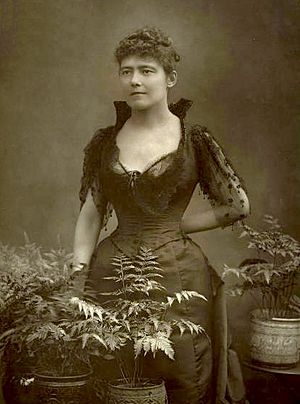Louise Jopling facts for kids
Quick facts for kids
Louise Jopling
|
|
|---|---|

Photograph of Louise Jopling
by Herbert Rose Barraud |
|
| Born |
Louise Jane Goode
16 November 1843 Manchester, United Kingdom
|
| Died | 19 November 1933 (aged 90) Chesham Bois, United Kingdom
|
| Nationality | British |
| Known for | Painting |
| Spouse(s) | Frank Romer Joseph Middleton Jopling George W. Rowe |
Louise Jane Jopling (born Goode, later Romer and Rowe) was an important English painter. She lived during the Victorian era (1837-1901). Louise was one of the most famous female artists of her time. She was born in Manchester, England, on November 16, 1843, and passed away on November 19, 1933.
Contents
Becoming an Artist: Louise Jopling's Early Life
Louise Jane Goode was born in Manchester. She was the fifth of nine children. Her father, Thomas Smith Goode, built railways. When she was 17, Louise married Frank Romer, who worked for the government. A friend of her husband's, Baroness de Rothschild, saw Louise's talent. She encouraged Louise to become an artist.
In the late 1860s, Louise studied art in Paris, France. She learned from famous painters like Charles Joshua Chaplin. She also started showing her artwork in big exhibitions. One of these was the Paris Salon. From 1870 to 1873, she showed her paintings at the Royal Academy of Arts in London.
After her first husband died in 1872, Louise married Joseph Middleton Jopling in 1874. He was also an artist. Louise had two sons, Percy from her first marriage and Lindsay from her second. Lindsay was named after two important artists, Coutts Lindsay and John Everett Millais.
Success and Challenges for a Female Artist
Louise Jopling became quite successful. In 1874, her painting Five O'Clock Tea sold for a lot of money. Her art was shown at major events around the world. These included the Philadelphia Exposition in 1876 and the Paris Exposition in 1878.
However, being a woman artist in her time was not always easy. In 1883, she wanted to paint a portrait for a client. She asked for 150 guineas (an old type of British money). But the job went to a male artist, Sir John Everett Millais, who was paid 1000 guineas for the same work. This shows how women artists often earned less than men.
Louise Jopling also showed her art at the 1893 World's Columbian Exposition in Chicago. Her paintings were displayed in the Palace of Fine Arts and The Woman's Building. She joined important art groups like the Society of Women Artists. In 1901, she became one of the first women allowed into the Royal Society of British Artists. Louise often earned most of the money for her family. This meant she had to paint and sell her work all the time.
Louise Jopling's Social Connections
Louise Jopling painted portraits of many important people. These included wealthy people and famous actresses. To do this, she lived a stylish life. Her art studio in Chelsea, London, was even designed by a famous architect, William Burges.
She was friends with many well-known figures of her time. These included artists like James Abbott McNeill Whistler and writers like Oscar Wilde. She was also friends with Kate Perugini, who was Charles Dickens' daughter, and the famous actress Ellen Terry.
Her home was a popular place for gatherings. In 1887, a magazine called The Lady's World wrote about her social life. They mentioned that her portrait by Sir John Millais hung in her home. They also said that James Whistler and Oscar Wilde often discussed art there. Other famous artists like John Singer Sargent were also her friends.
At one of Louise's parties in 1883, a funny conversation happened between Whistler and Oscar Wilde. Wilde said, "How I wish I had said that," after Whistler made a clever remark. Whistler quickly replied, "You will, Oscar, you will."
Like some other women painters, Louise Jopling also posed for other artists. Both Millais and James Abbott McNeill Whistler painted her portrait. Whistler even called Millais's painting of Louise "a great work."
Later Life and Legacy
After Joseph Jopling died in 1884, Louise married lawyer George W. Rowe in 1887. She continued to use Jopling as her professional name. Louise started her own art school specifically for women. In 1887, she wrote articles about teaching art. She strongly believed that female art students should be able to draw from live models. At the time, the Royal Academy of Arts only allowed women to observe male models who were "carefully draped." Her friend Whistler even helped by giving out prizes at her school.
Louise Jopling was a strong supporter of women's suffrage, which meant women's right to vote. She was also active in other feminist causes. She helped lead a group that promoted healthier and more artistic clothing. She also wrote a book about art instruction and her own life story, called Twenty Years of My Life. She even wrote some poetry and newspaper articles.



